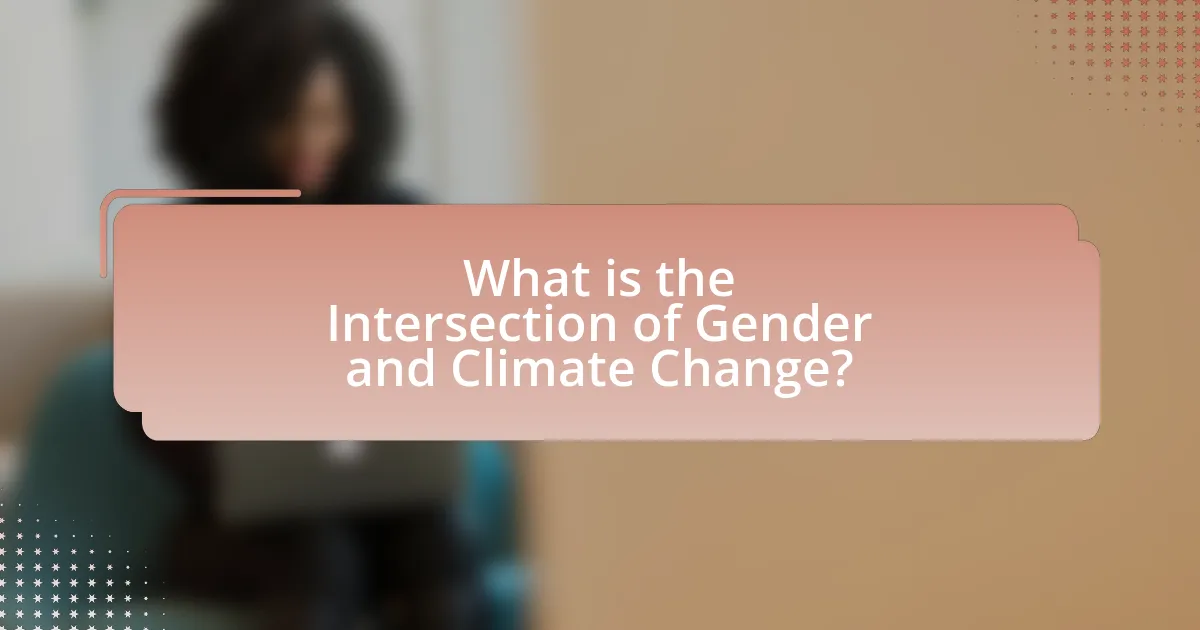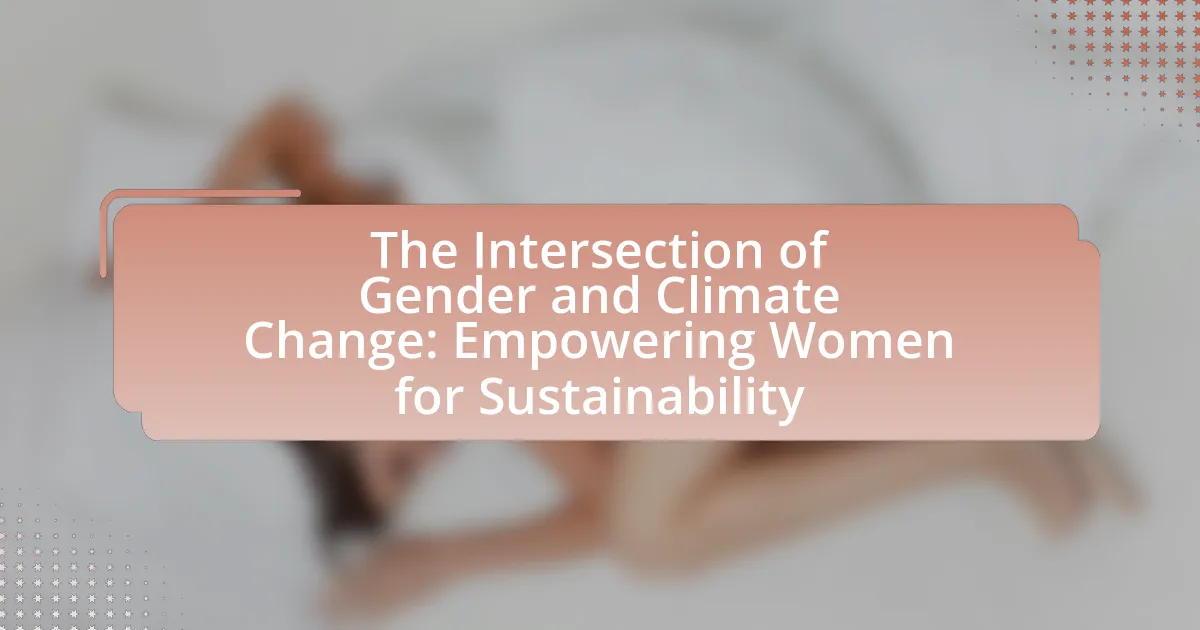The article examines the intersection of gender and climate change, highlighting how climate change disproportionately impacts women, particularly in developing countries, due to existing social inequalities and limited access to resources. It discusses the specific challenges women face in climate-affected regions, including food insecurity and gender-based violence, and emphasizes the importance of empowering women in climate action for more effective and sustainable solutions. The article outlines key strategies for women’s empowerment, such as education, access to resources, and gender-responsive policies, while also addressing systemic barriers that hinder women’s participation in sustainability efforts. Additionally, it highlights the role of grassroots movements and the benefits of gender collaboration in enhancing climate resilience and sustainability initiatives.

What is the Intersection of Gender and Climate Change?
The intersection of gender and climate change refers to the ways in which climate change disproportionately affects women and how gender dynamics influence responses to climate challenges. Women, particularly in developing countries, often bear the brunt of climate impacts due to existing social inequalities, limited access to resources, and decision-making power. For instance, the United Nations reports that women are more likely to be affected by climate-related disasters, as they often have less access to information, technology, and financial resources needed for adaptation. Additionally, empowering women in climate action can lead to more effective and sustainable solutions, as studies show that gender-inclusive policies enhance resilience and improve environmental outcomes.
How does gender influence vulnerability to climate change?
Gender significantly influences vulnerability to climate change by affecting access to resources, decision-making power, and social roles. Women, particularly in developing countries, often have less access to education, financial resources, and technology, which limits their ability to adapt to climate impacts. For instance, the United Nations reports that women make up 70% of the world’s poor, making them more susceptible to climate-related disasters. Additionally, traditional gender roles often assign women the responsibility for water and food security, increasing their exposure to climate risks. Research by the World Bank indicates that gender inequality exacerbates the effects of climate change, highlighting the need for gender-sensitive policies to enhance resilience and empower women in climate adaptation strategies.
What specific challenges do women face in climate-affected regions?
Women in climate-affected regions face specific challenges such as increased vulnerability to food insecurity, limited access to resources, and heightened exposure to gender-based violence. These challenges arise because women often have primary responsibilities for food production and household management, making them more susceptible to the impacts of climate change, such as droughts and floods. For instance, according to the Food and Agriculture Organization, women represent about 43% of the agricultural labor force in developing countries, yet they have less access to land, credit, and technology, which exacerbates their vulnerability in times of climate stress. Additionally, during climate-related disasters, women are at a higher risk of experiencing violence and exploitation, as evidenced by reports from the United Nations, which highlight that women and girls are disproportionately affected in crisis situations.
How do cultural factors impact women’s roles in climate resilience?
Cultural factors significantly influence women’s roles in climate resilience by shaping their access to resources, decision-making power, and community involvement. In many societies, traditional gender roles restrict women’s participation in environmental management, limiting their ability to contribute to climate adaptation strategies. For instance, in regions where women are primarily responsible for water and food security, their knowledge and practices are crucial for developing sustainable solutions. Research by the United Nations Development Programme highlights that empowering women in these roles can enhance community resilience to climate impacts, as women often possess unique insights into local ecosystems and resource management. Thus, cultural norms that promote gender equality can enhance women’s contributions to climate resilience efforts.
Why is it important to empower women in climate action?
Empowering women in climate action is crucial because women play a vital role in environmental management and sustainability. Studies show that women are often the primary managers of natural resources in their communities, and their involvement leads to more effective climate solutions. For instance, the Food and Agriculture Organization (FAO) reports that when women have equal access to resources, agricultural productivity can increase by 20-30%, which directly contributes to food security and climate resilience. Furthermore, women’s perspectives and experiences can enhance decision-making processes, leading to more inclusive and effective climate policies. Thus, empowering women not only promotes gender equality but also strengthens the overall response to climate change.
What evidence supports the role of women in sustainable practices?
Evidence supporting the role of women in sustainable practices includes their significant contributions to agriculture, resource management, and community resilience. Research indicates that women are responsible for producing over 50% of the world’s food, particularly in developing countries, where they manage smallholder farms that utilize sustainable practices. A study by the Food and Agriculture Organization (FAO) highlights that increasing women’s access to resources and training can enhance agricultural productivity by 20-30%, which directly contributes to food security and sustainable development. Furthermore, women often play key roles in community-based conservation efforts, as seen in various case studies where women’s involvement in managing natural resources leads to improved biodiversity outcomes. These findings collectively demonstrate that empowering women is crucial for advancing sustainable practices and addressing climate change effectively.
How can women’s empowerment lead to better climate outcomes?
Women’s empowerment can lead to better climate outcomes by enhancing decision-making and resource management in environmental initiatives. When women are empowered, they often take on leadership roles in community-based climate action, which has been shown to improve the effectiveness of sustainability projects. For instance, a study by the Food and Agriculture Organization (FAO) found that women’s participation in agricultural decision-making can increase crop yields by 20-30%, thereby contributing to food security and resilience against climate change. Furthermore, empowered women are more likely to advocate for sustainable practices and policies, as evidenced by the UN Women report highlighting that countries with higher gender equality tend to have stronger environmental policies. This correlation underscores the importance of integrating gender perspectives into climate strategies to achieve more effective and equitable climate solutions.

What are the key strategies for empowering women in sustainability?
Key strategies for empowering women in sustainability include promoting education and training, enhancing access to resources, and fostering leadership opportunities. Education and training equip women with the necessary skills to engage in sustainable practices, as evidenced by the United Nations’ emphasis on education as a critical factor for achieving gender equality and sustainable development. Enhancing access to resources, such as land, finance, and technology, enables women to participate actively in sustainable initiatives; for instance, studies show that when women have equal access to agricultural resources, productivity can increase by 20-30%. Lastly, fostering leadership opportunities for women in decision-making roles ensures that their perspectives are included in sustainability policies, which is supported by research indicating that diverse leadership leads to more effective environmental governance.
How can education and training enhance women’s roles in sustainability?
Education and training can significantly enhance women’s roles in sustainability by equipping them with the knowledge and skills necessary to address environmental challenges. For instance, programs focused on sustainable agriculture, renewable energy, and environmental management empower women to lead initiatives that promote ecological conservation and resource management. Research indicates that when women receive education in these areas, they are more likely to implement sustainable practices in their communities, leading to improved environmental outcomes. A study by the Food and Agriculture Organization found that women farmers who received training in sustainable practices increased their crop yields by 20-30%, demonstrating the direct impact of education on sustainability efforts.
What types of education programs are most effective for women?
Education programs that are most effective for women include vocational training, STEM education, and leadership development initiatives. Vocational training equips women with practical skills that enhance employability and economic independence, which is crucial in addressing gender disparities. STEM education encourages women to pursue careers in science, technology, engineering, and mathematics, fields where they are underrepresented; studies show that women in STEM fields can significantly contribute to sustainable development. Leadership development initiatives empower women to take on decision-making roles, fostering gender equality and enabling them to influence policies related to climate change and sustainability. These programs have been shown to improve women’s participation in the workforce and enhance their ability to contribute to sustainable practices, as evidenced by various reports from organizations like UNESCO and the World Bank.
How does access to resources improve women’s participation in sustainability?
Access to resources significantly enhances women’s participation in sustainability by enabling them to engage in decision-making processes and implement sustainable practices. When women have access to financial resources, education, and technology, they are more likely to adopt environmentally friendly practices, such as sustainable agriculture and renewable energy use. For instance, a study by the Food and Agriculture Organization (FAO) found that women farmers who received training and resources increased their crop yields by 20-30%, demonstrating their potential impact on food security and sustainability. Furthermore, access to resources empowers women to advocate for policies that promote environmental sustainability, thereby increasing their influence in community and governmental decision-making.
What policies can support women’s empowerment in climate initiatives?
Policies that can support women’s empowerment in climate initiatives include gender-responsive climate policies, access to education and training, and financial support for women-led projects. Gender-responsive climate policies ensure that women’s needs and perspectives are integrated into climate action plans, which can enhance their participation and leadership in sustainability efforts. Access to education and training equips women with the skills necessary to engage in climate initiatives effectively, as evidenced by programs that have increased women’s involvement in renewable energy sectors. Financial support for women-led projects, such as microfinance initiatives, has been shown to improve women’s economic status and enable them to contribute to climate resilience, as highlighted in the UN Women report on gender and climate change.
Which international frameworks promote gender equality in climate action?
International frameworks that promote gender equality in climate action include the United Nations Framework Convention on Climate Change (UNFCCC), the Paris Agreement, and the Gender Action Plan. The UNFCCC emphasizes the importance of integrating gender considerations into climate policies and actions, recognizing that women are disproportionately affected by climate change. The Paris Agreement includes provisions that encourage parties to consider gender equality in their climate commitments. Additionally, the Gender Action Plan, adopted at the 2017 UNFCCC Conference of the Parties, specifically aims to enhance the participation of women in climate decision-making processes and ensure gender-responsive climate policies. These frameworks collectively support the integration of gender equality into climate action, thereby empowering women and promoting sustainable development.
How can local governments implement gender-sensitive climate policies?
Local governments can implement gender-sensitive climate policies by integrating gender analysis into climate action plans and ensuring women’s participation in decision-making processes. This approach recognizes that women often experience the impacts of climate change differently than men and can contribute unique perspectives and solutions. For instance, the United Nations Framework Convention on Climate Change emphasizes the importance of gender-responsive approaches, highlighting that women’s involvement can lead to more effective climate strategies. Additionally, research from the World Bank indicates that empowering women in climate resilience initiatives can enhance community adaptation efforts, demonstrating the tangible benefits of gender-sensitive policies.
What are the challenges and barriers to women’s empowerment in climate change?
The challenges and barriers to women’s empowerment in climate change include limited access to resources, lack of representation in decision-making processes, and socio-cultural norms that restrict women’s roles. Limited access to financial resources and technology hinders women’s ability to adapt to climate impacts, as evidenced by the fact that women in developing countries often have less access to credit and land ownership. Additionally, women’s underrepresentation in climate policy discussions results in their needs and perspectives being overlooked, which is highlighted by studies showing that women make up only 30% of participants in climate negotiations. Socio-cultural norms often dictate gender roles, leading to women’s voices being marginalized in both community and governmental contexts, which further exacerbates their vulnerability to climate change effects.
What systemic issues hinder women’s participation in climate solutions?
Systemic issues that hinder women’s participation in climate solutions include gender inequality, lack of access to resources, and insufficient representation in decision-making processes. Gender inequality manifests in social norms and cultural barriers that limit women’s roles in environmental governance. For instance, women often face discrimination in accessing land, credit, and technology, which are crucial for implementing climate solutions. Additionally, women are underrepresented in leadership positions within climate-related organizations, which diminishes their influence on policy-making. According to the United Nations Development Programme, women make up only 30% of decision-making roles in climate-related sectors, highlighting the systemic barriers they encounter.
How do economic disparities affect women’s involvement in sustainability?
Economic disparities significantly limit women’s involvement in sustainability initiatives. Women in economically disadvantaged regions often lack access to education, resources, and decision-making power, which are crucial for participating in sustainability efforts. For instance, a report by the United Nations Development Programme highlights that women represent 43% of the agricultural labor force in developing countries but face barriers such as limited access to land and credit, which hinders their ability to engage in sustainable agricultural practices. Furthermore, economic inequality restricts women’s ability to invest in sustainable technologies or participate in environmental governance, thereby reducing their overall impact on sustainability efforts.
What role does social stigma play in limiting women’s contributions?
Social stigma significantly limits women’s contributions by perpetuating stereotypes that undermine their capabilities and roles in various sectors, including sustainability. For instance, women often face societal expectations that prioritize domestic responsibilities over professional or community engagement, which restricts their participation in decision-making processes related to climate change. Research indicates that women are underrepresented in leadership roles, with only 24% of national parliamentarians globally being women, reflecting the impact of stigma on their visibility and influence. This underrepresentation hinders diverse perspectives essential for effective climate action, as women’s unique experiences and knowledge are crucial for developing sustainable solutions.
How can communities overcome these barriers to empower women?
Communities can overcome barriers to empower women by implementing targeted educational programs and promoting gender-inclusive policies. Educational initiatives that focus on climate change and sustainability can equip women with the knowledge and skills necessary to participate in decision-making processes. For example, the United Nations reports that when women are educated, they are more likely to contribute to sustainable practices, which can lead to improved community resilience against climate impacts. Additionally, communities can advocate for policies that ensure equal access to resources, such as land and financial services, which are crucial for women’s empowerment. Research from the World Bank indicates that gender equality in access to resources can significantly enhance economic growth and sustainability. By fostering an environment that prioritizes education and equitable resource distribution, communities can effectively empower women and address the challenges posed by climate change.
What grassroots movements are successfully promoting women’s roles in climate action?
Grassroots movements such as Women’s Earth Alliance and the Global Women’s Network for the Energy Transition are successfully promoting women’s roles in climate action. Women’s Earth Alliance empowers women globally by providing training and resources to lead sustainable initiatives, while the Global Women’s Network for the Energy Transition focuses on integrating women into energy solutions, advocating for their participation in decision-making processes. These movements demonstrate the critical role women play in addressing climate challenges, supported by evidence that women are often more affected by climate change and are key to effective environmental stewardship.
How can collaboration between genders enhance sustainability efforts?
Collaboration between genders can enhance sustainability efforts by integrating diverse perspectives and experiences, leading to more innovative and effective solutions. Research indicates that gender-diverse teams are more likely to produce creative ideas and approaches, which is crucial for addressing complex sustainability challenges. For instance, a study published in the journal “Nature” found that organizations with higher gender diversity in leadership positions are more successful in implementing sustainable practices. This is because women often bring unique insights into resource management and community engagement, which are essential for developing sustainable strategies. Therefore, fostering collaboration between genders not only promotes equality but also significantly contributes to more robust sustainability initiatives.
What practical steps can individuals take to support women’s empowerment in sustainability?
Individuals can support women’s empowerment in sustainability by actively promoting and participating in initiatives that prioritize gender equality in environmental decision-making. For instance, individuals can advocate for policies that ensure women’s representation in leadership roles within environmental organizations, as studies show that diverse leadership leads to more effective sustainability outcomes. Additionally, individuals can support women-led sustainable businesses by purchasing products and services from these enterprises, which not only boosts their economic independence but also fosters innovative solutions to environmental challenges. Engaging in community education programs that focus on women’s roles in sustainability can further enhance awareness and skills, empowering women to take action in their local environments.


